
There are many different types and breeds of huskies including: the Alaskan Malamute, the Siberian, the Alaskan Husky and more. This list includes; the Akita Husky, American Eskimo dogs and the Chinook Dog. Additionally, in the husky dog universe we can also find; the Finnish Spitz, Keeshond, Samoyed Husky, Schipperke Husky, ShibaInu, Red and White Husky, Norwegian Elkhound and the Miniature Husky.
There are so many different breeds of husky dogs that we here at AnimalWised wanted to discuss them with you! For more information take a look at our useful guide of the types and breeds of husky dogs. While each of these species may resemble the other, there are also significant differences between the different husky types and breeds.
How many Husky breeds are there?
There are some terms applied to different dogs which appear to refer to their breed. Pit Bull dogs is one such term. However, this is often a loose definition which is applied to certain types of dogs, but do not refer to an actual breed. Husky dogs is another description which falls into this category.
This doesn't mean that the term ‘husky dog’ isn't accurate. It is an appropriate term which is used to apply to sled-dogs used in Northern territories to traverse often icy and snowy terrain. While the word derives from indigenous peoples from the Arctic regions, in particular the Eskimo people. However, the actual word for husky dogs was likely created by English sailors who were referring to dogs of the Inuit people.
Actual breeds which have the term Husky applied to them aren't necessarily actual Husky dogs. This is because Huskies are varied and changing continuously with further cross-breeding. For this reason, the dogs here on our list of Husky types and breeds are so due to the above description. This means there is the potential for more dog breeds to be considered Husky dogs in the future.
The Alaskan Malamute
The Alaskan Malamute is Alaska's official mascot. This is the oldest among the north sled dogs. Named after an Inuit tribe of the same name, this husky breed has been used to provide companionship and pull sleds through the Arctic terrain.
The Malamute differs from the Siberian husky in many ways. Some of these differences can be noted by the fact that the Malamute is taller and heavier than the Siberian husky, 23 to 25 inches in height at the shoulder, this dog can weigh anywhere between 75 to even 100 pounds. The distinctive appearance of the Malamute includes brown eyes and a broad head distantly placed eyes.
Malamute huskies have a bushy tail and though powerful, they use sharp paws to dig instead of jumping over fences. This dog loves to go on jaunts and can be aggressive with other species, but loyal and caring to his human companions. Because it has long and thick double coat, it's highly important to know how to care for an Alaskan Malamute during summer. You need to make sure that its coat is cared for correctly to avoid pathologies, such as; heat stroke.
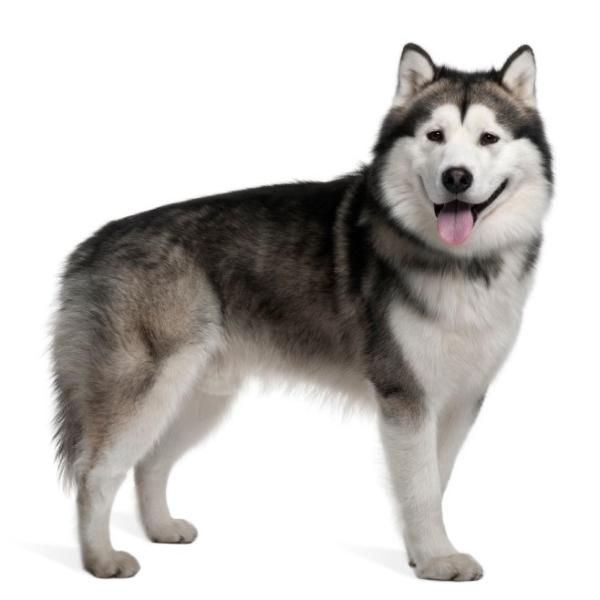
The Siberian Husky
This type is also known as the red and white husky. The Siberian Husky, as its name suggests, is from Siberia. This husky breed was used by semi-nomadic tribes known as the Chuckchi. The breed was developed to carry sleds across frozen terrain for both daily living and races. In 1909, the first Siberian Huskies arrived in Alaska as racing dogs, the most famous being Balto, the dog that became a hero.
At 35 to 60 pounds and 20 to 23 and a half inches at the withes, the Siberian Husky is smaller boned than the Malamute. With a smaller head, eyes and ears set close together, and a sickle-shaped, bushy tail, the Siberian Husky is adorably cute. The Siberian Husky moves in packs when in the wild and have strong prey drive. As the Malamute, you should know that Siberian Huskies shed not once, but twice a year.
In addition, there are different types of Siberian Husky. These Siberian husky breeds include the Akita or Schipperke Husky, which are a mix of the respective breeds and the Siberian Husky. A Samoyed Husky, for example, is a cross between a Samoyed and a Siberian Husky (more below).
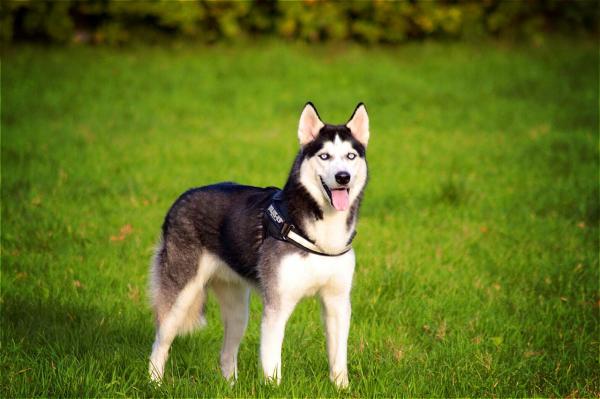
The Alaskan Husky
The Alaskan husky is a great companion dog as well as very alert. While the AKC of the US recognizes the Malamute and the Siberian Husky as purebreds, the Alaskan Husky is judged on the basis of its abilities, not its appearance. This husky breed vary in appearance.They are long legged, lean bodied, sport a deep chest with pointy ears and a tail curling over its back. These dogs generally have brown eyes. Weighing anywhere between 35 to 50 pounds, they are taller than the Siberian Husky carrying a wolf-like appearance. The Siberian or Malamute husky breeds are not as fast as the Alaskan Husky.

Samoyed
The Samoyed is often incorrectly referred to as a Samoyed Husky, but it is not a distinct husky breed. Rather, it is a Eurasian sled-dog which has many similar traits to other Husky breeds. They are descended from Spitz dogs and other Northern dog breeds. An extremely friendly and affable dog, the Samoyed is more commonly seen as a companion animal rather than working sled-dog.
Due to its working husky heritage, the Samoyed requires training to avoid unwanted behavior. However, this unwanted behavior is more likely to be running off the play happily with other people or dogs as aggression is rare. As with all husky dogs, they have a thick double coat which helps to protect against cold temperatures. They need lots of brushing.
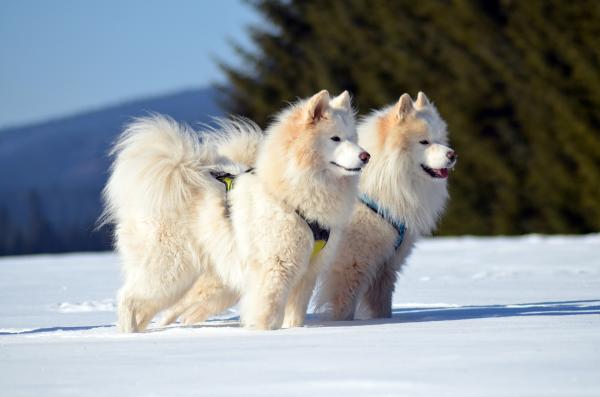
Labrador Husky
Although this may sound like a reference to a crossbreed of the Labrador Retriever and a Husky breed, the Labrador Husky is actually a distinct breed. There is a province in Canada known as Newfoundland and Labrador where both breed originate, but the Labrador Husky took a different path genealogically. They are a medium to large dog breed which shares many similarities with other huskies, including a thick coat, boundless energy and even temperament.
The Labrador Husky does have some wolf-heritage, but not recent. They are possibly one of the huskies which most resembles their wolf-cousins. Labrador Huskies do have a strong-prey drive, so they need to be carefully socialized with smaller animals if they are expected to live together. As with all husky breeds, these huskies need to have plenty of exercise. While energetic and active, they are prone to certain health issues such as hip dysplasia.
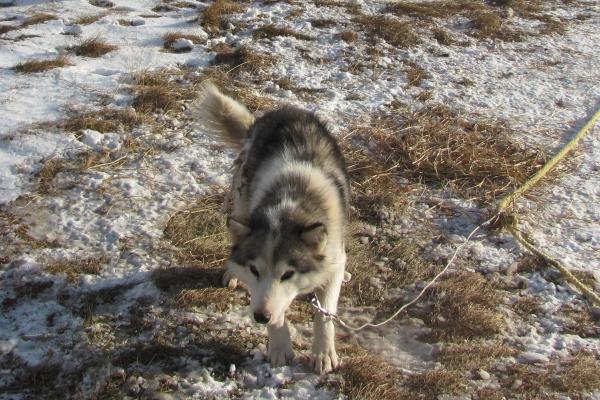
What are some husky cross-breeds?
The Eurohound is a cross between an Alaskan Husky and the English or German pointer. Quick-footed navigation and successes on the racing circuit make these less furry huskies breed a dog to contend with.
In addition to the Eurohound we find the Miniature Huskies breeds. These dogs look-like like a Siberian Husky but on a smaller scale. They have the same fiery, energetic, independent-minded temperament as Siberian Huskies. Mini Huskies were bred in the 1990s. These cute bundles of joy come from the Spitz family and are descendants of the original northern sled dog. Like other husky breeds, they have a strong prey instinct but are seemingly less active. They are very loyal and loving when it comes to caring for their families.
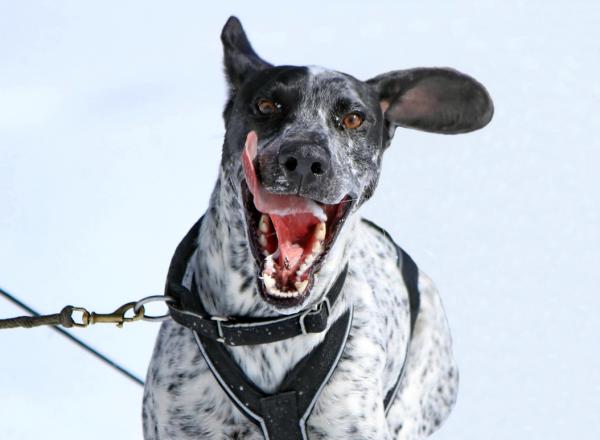
If you want to read similar articles to Types and Breeds of Husky Dogs, we recommend you visit our Facts about the animal kingdom category.